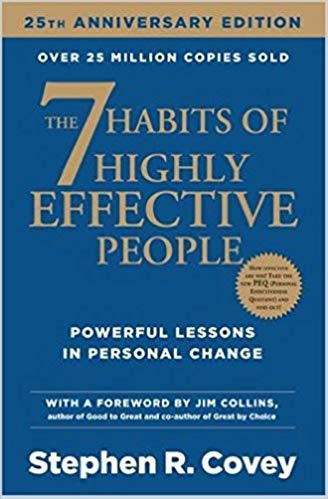

This article is an excerpt from the Shortform summary of "The 7 Habits of Highly Effective People" by Stephen Covey. Shortform has the world's best summaries of books you should be reading.
Like this article? Sign up for a free trial here .
What is Habit 2 of the 7 habits of highly effective people? What does Habit 2: begin with the end in mind mean?
After tackling Habit 1 in the 7 Habits of Highly Effective People, you should be ready for Habit 2: Begin with the End in Mind. Beginning with the End in Mind prepares you for the task of writing your own destiny, and give you the tools to plot your chart.
What Does Habit 2: Begin with the End in Mind Mean?
To achieve the life you want, you must start with the end in mind. This means identifying the big picture — the life you want to lead, the character traits you want to embody, the impact you want to have on those around you — and then ensuring each daily action is in line with your ultimate goals.
Think of driving to an appointment: How can you know which streets to take and turns to make if you don’t know where your destination is? Without a destination in mind, you might still make it there eventually, but it’ll be a long and roundabout route to get there. Effectiveness is following a direct route to get to your destination.
It’s easy to get sucked into the fast pace and stress of day-to-day life, working furiously to climb the ladder — but sometimes you reach the top rung only to realize that the ladder was leaned up against the wrong wall. You may accomplish a short-term goal (e.g. a job promotion, an income level, a diet goal), but when you get there you realize that along the way you sacrificed things that were more important in the grand scheme of things.
If you use habit 2: begin with the end in mind, you create everything twice: You first envision the result you want and the efforts that must go into achieving it, and then you carry it out. Begin every day by reaffirming your values and your destination, and that will help you carry out every action throughout the day in pursuit of that goal.
Examples of Habit 2: Begin with the End in Mind
- In home construction, your first creation is the blueprint, showing where every beam and doorway will be placed. To avoid expensive mistakes, you don’t hammer a single nail until every detail has been planned out.
- In business, you can’t launch a company until you’ve outlined every aspect: What product or service are you selling, who is your target market, how are you reaching it, what will your financial structure be, how many employees will you need? Acting before you’ve created a thorough business plan makes it very difficult, if not impossible, to succeed.
- In parenting, if you want your children to grow up to be independent, responsible, and caring, you must try to work toward that goal in every interaction you have with them — through every tantrum and challenge and success.
Now that you understand what habit 2: begin with the end in mind means, we can explore the tools that make this possible.
Creating a Vision
Leaders are responsible for staying aware of the big picture — the first creation — and ensuring that each action is moving in that direction. Whether you’re leading a team or practicing personal leadership, one of the challenges of being a good leader is resisting the urge to get distracted by small day-to-day matters.
In a business setting, an organization functions like a group of people finding their way through a jungle.
- The employees forge progress by hacking their way through the underbrush. They’re dealing with customers and daily problems to help move the company forward.
- The managers support the employees by walking with them and along the way sharpening their machetes, offering strength-building and machete-swinging trainings, giving them new high-tech machetes, and creating work and payment schedules.
- The leader climbs to the top of a tall tree to get a bird’s-eye view of where the employees and managers are heading through the underbrush. If they’ve ended up in the wrong direction, the leader can yell down to the crew that they’re in the wrong jungle.
Leaders are responsible for being aware of changing industry and market conditions, and effective leaders can’t have this big-picture view if they allow themselves to get caught up in the underbrush.
Personal leadership follows the same principle: You’re leading your life in a deliberate way toward your goals. Although you have to also be your own manager and machete-swinger, if you don’t keep your attention on the big picture — your first creation — you could end up in the wrong jungle. This is why Stephen Covey says to begin with the end in mind- so you know where you’re going.
Stay Focused with Your Personal Mission Statement
As life constantly changes, how do you keep your focus on your values and goals? How do you make sure every small action you make is moving you closer to your destination? You can create a personal mission statement, an essential part of habit 2, begin with the end in mind.
A personal mission statement focuses on three main things:
- Character: Who do you want to be?
- Contribution: What do you want to do?
- Achievements: What are the core values and principles that govern your character and contributions?
Your personal mission statement is the standard by which everything is everything is measured and directed. Crystallizing the changeless core of who you are actually helps you adapt to change, because it reinforces such a secure sense of self that you won’t be threatened by changes around you.
Develop Your Mission Statement
Start by looking at the most basic paradigms that dictate how you see the world. As you examine these paradigms, they’ll reveal your innermost values and principles and help you use habit 2: begin with the end in mind.
Each person’s mission statement will be distinct because everyone is unique and has individual experiences; rather than inventing your mission or emulating someone else’s, try to find your mission through self-examination, reflection, and honest assessment of your unique strengths and values.
Remember, Stephen’ Covey’s idea “begin with the end in mind” is about the process, too. The process itself is just as important as the final result, because it makes you think through how you want to live your life and what actions reinforce that.
Create Group Mission Statements
Mission statements are also effective for groups who want to begin with the end in mind— whether families, organizations, or businesses.
It’s critical that everyone in the group be involved in creating the mission statement. This process gets all the group members thinking and talking about what matters to them, and what they believe the group’s priorities should be.
If everyone is involved with creating the mission statement, they’re more likely to feel that it reflects their own values and to work harder to uphold it.
Identify Your Center
Creating your personal mission statement requires a process of deep reflection and self-evaluation as you examine your paradigms and discover the values that guide your decisions and actions.
Your paradigms determine four essential aspects of your life:
- Security: Your identity and self-worth, which grounds you and gives you strength.
- Guidance: The source of your direction in life, the factors that are influencing your choices and actions.
- Wisdom: How well you understand how different life principles interrelate and how you interpret how life works.
- Power: Your strength and capacity to act, including — and especially — when it entails being proactive and rewriting your habits.
Each of these factors falls on a continuum; it isn’t a matter of whether or not you have them, but where you fall on the spectrum. For instance, you could be highly insecure with a low self-worth and a shaky sense of identity, or you could have high self-esteem and a firm sense of who you are.
These factors are also interdependent, collectively strengthening the others. If you have a strong sense of security and clear guidance, this heightens your wisdom, which helps you access your power, and helps you create your journey so you can follow Stephen Covey’s begin with the end in mind.
Your Center Determines Your Experience
Your core paradigms reveal your center; you can be centered on your marriage, friendships, family, work, money, possessions, pleasure, or, ideally, principles. Whatever is at your center determines your security, guidance, wisdom, and power and is an important part of habit 2: begin with the end in mind.
The following are the most common centers:
- If you’re marriage-centered, your sense of identity and self-worth is determined by the health of your relationship at that moment.
- If you’re family-centered, you derive your security from the strength of your family traditions and reputation.
- Surprisingly, being friend- or enemy-centered is largely the same; in both contexts, your interactions with other people, their opinions of you, and their treatment of you determine your sense of self-worth.
- If you’re money-centered, your self-worth changes with the rise and fall of your net worth.
- If you’re work-centered, you base your identity in your profession and your position at work.
- If you’re possession-centered, your focus and self-worth are tied up in material possessions (e.g. cars, homes, and nice clothes) or intangible possessions (e.g. social status, authority, and recognition).
- If you’re pleasure-centered, your main priority is on having fun and maximizing your pleasure in life, to the neglect of work, relationships, and self-discipline.
- Being church-centered emphasizes the appearance of being involved in the community, meeting social standards, and clearly displaying your membership in the group.
- If you’re self-centered, you’re driven more by selfishness than by an earnest attempt to develop and improve yourself.
Your center(s) determines the decisions you make and how you navigate life. In a given situation, several different centers might lead to the same outcome; however, your experience will be different based on the paradigm that led you to it. Furthermore, your motivations and experiences have a greater impact on your life than your specific actions.
How to Practice Habit 2: Begin with the End in Mind
We discussed earlier that a balanced mission statement needs to include goals in every role you have in life. Similarly, a balanced approach to self-improvement requires you to use both sides of your brain.
Each side of the brain is responsible for different functions: The right side of the brain is creative, abstract. The left side of the brain deals with logic and language. You need to be both creative and logical as you take a holistic approach to growth and change in order to begin with the end in mind. Many people feel more comfortable using one side over the other, and society tends to emphasize certain types of thinking over others. But to begin with the end, you need both.
The right brain is critical for being proactive and creating paradigm shifts because it encompasses the imagination and creativity you need to dream up how you want your life to be, and what you can do to get there. You need your left brain to then crystallize that image and desire into a personal mission statement.
Visualization
Visualization entails imagining yourself in a situation that puts life in a larger perspective. If you’re trying to improve a specific skill, habit, or area of your life, visualize a scenario that causes you to have the reaction that you’re trying to change.
For example, if you’re trying to improve your interactions with your kids, visualize a situation in which they do something that would normally anger you. Instead of allowing your normal response to kick in — even in this imaginary scenario — visualize yourself practicing the patience and understanding that you want to embody in the future.
Visualization works best if you visualize in great detail — down to the smell of the room, the texture of the clothes you’re wearing, the feeling of that experience. Dedicate a few minutes each day to practicing this visualization. Separate yourself from distractions and allow your mind and body to totally relax while you do this.
High-performing people, from professional athletes to NASA astronauts, use visualization techniques to prepare them for critical moments, whether it’s the fourth quarter in a tie game or the space shuttle launch. Visualizing a situation in vivid detail and imagining yourself navigating it exactly the way you want to makes you more comfortable with that situation when it happens in reality. If everything is created twice, visualization is the first creation.
Affirmations
Similarly, affirmations are written or verbal reminders that you create to help you remember your goals. Just as a mission statement helps you to keep your focus on your goals and values, affirmations work the same way on a smaller scale, applying to one specific behavior or area of your life.
An effective affirmation has five key components:
- It’s personal. It focuses on you.
- It’s positive. It frames things in a positive light, focusing on something you want to create, not what you want to avoid.
- It’s visual. It lays out a specific situation when the affirmation is applicable.
- It’s in the present tense.
- It’s emotional. It specifies how you feel when you take this action.
Visualizations and affirmations are actions you can do daily to reinforce your larger self-improvement goals and efforts in your life.
Habit 2: begin with the end in mind is one of the 7 habits that can help you learn to create goals based on who you are and what you hope to achieve. By cultivating this habit, you are on your way to further growth and fulfillment.
———End of Preview———

Like what you just read? Read the rest of the world's best summary of "The 7 Habits of Highly Effective People" at Shortform . Learn the book's critical concepts in 20 minutes or less .
Here's what you'll find in our full The 7 Habits of Highly Effective People summary :
- How to prioritize the hundred tasks you have to focus on the one or two that really matter
- The right way to resolve every disagreement and argument
- How to avoid burning out and succeed over 20+ years







How many people really begin with the end in mind